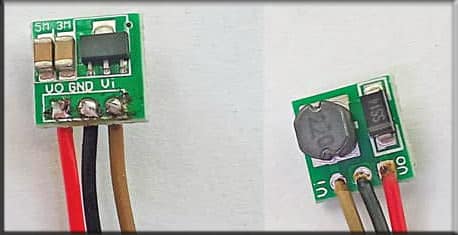
Obtaining 5V from AA or AAA cells is a difficult task in terms of high efficiency and a low component count. Classic boost converter circuits are challenging to implement in portable devices like wireless mice, remotes, etc.
Presented here is a 5V Boost Converter Circuit that generates 5V from 1.5V or any single cell by using only three external components. The prototype assembled on a double-sided PCB is shown in Fig. 1.

POC Video Tutorial In English:
The components required for this 5V Boost Converter Circuit to generate 5V from single cells are listed below-
| Bill of Materials | |
| Components | Quantity |
| CE8301(IC1) | 1 |
| 1N5819 (D1) | 1 |
| On-off switch (SW1) | 1 |
| 22µH inductor (L1) | 1 |
| 100µF, 16V (C1, C2) | 2 |
| 2-pin connector | 2 |
5V Boost Converter – Circuit and Working
Pulse frequency modulation (PFM) is a switching method normally used in many DC-DC voltage converters to improve efficiency at light loads.
The circuit is built around PFM DC-DC boost converter chip CE8301 (IC1), an inductor 22µH (L1), a Schottky barrier diode 1N5819 (D1), and a few other components.
A single 1.5V cell is connected to connector CON1. Switch SW1 is used to turn on/off the circuit.
When the switch is closed, IC1 and inductor L1 perform the step-up operation, and the 5V output voltage is available at CON2.
Capacitor C2 is used to reduce the voltage ripple in the output voltage, while capacitor C1 acts as a buffer.
Please register to view this article or log in below. Tip: Please subscribe to EFY Prime to read the Prime articles.













